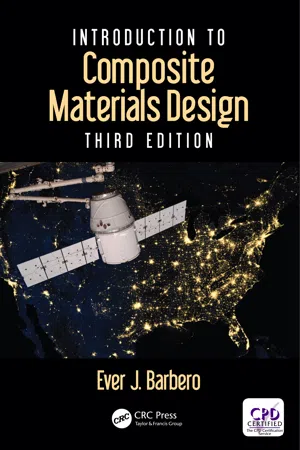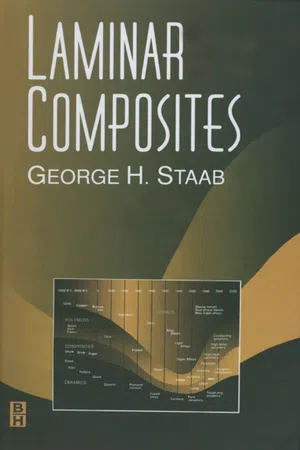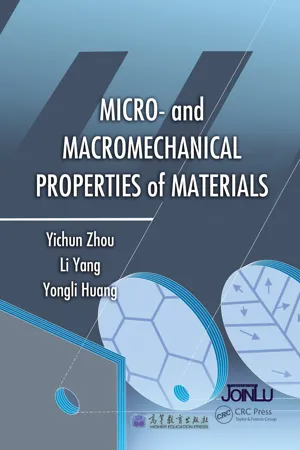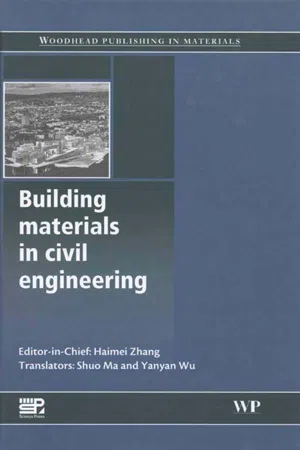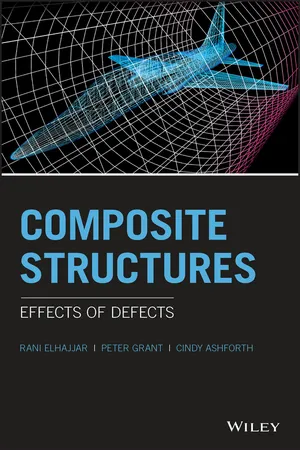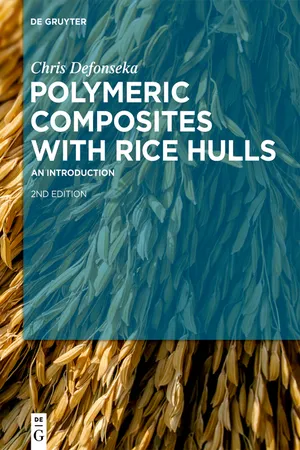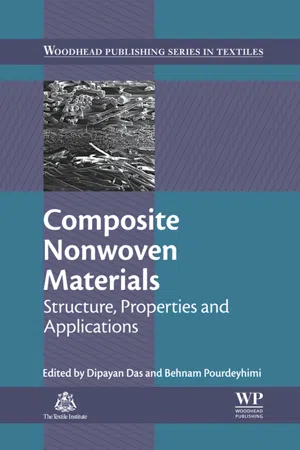Technology & Engineering
Properties of Composite Materials
Composite materials are engineered materials made from two or more constituent materials with significantly different physical or chemical properties. These materials are designed to exhibit unique properties that are not present in any single constituent material alone. The properties of composite materials can be tailored to meet specific performance requirements, making them widely used in various industries such as aerospace, automotive, and construction.
Written by Perlego with AI-assistance
Related key terms
Related key terms
1 of 4
Related key terms
1 of 3
9 Key excerpts on "Properties of Composite Materials"
- eBook - ePub
Composite Materials
Properties, Characterisation, and Applications
- Amit Sachdeva, Pramod Kumar Singh, Hee Woo Rhee, Amit Sachdeva, Pramod Kumar Singh, Hee Woo Rhee(Authors)
- 2021(Publication Date)
- CRC Press(Publisher)
3 Properties of Composite Materials Arvind Kumar Chauhan, Amarjeet Singh, Deepak Kumar and Kuldeep MishraContents
3.1Introduction 3.2Properties of Polymer-Matrix Composites 3.2.1Electrical Properties of Polymer Composites 3.2.2Mechanical Properties of Polymer Composites 3.3Properties of Ceramic-Matrix Composites 3.3.1Electrical Properties of Ceramic-Matrix Composites 3.3.2Mechanical Properties of Ceramic-Matrix Composites 3.4Properties of Metal-Matrix Composites 3.5Properties of Composite Materials used in Energy Storage/Conversion Devices 3.6Conclusions References3.1Introduction
Composite materials have a macroscopic structure containing two or more non-soluble materials. One old and well-known example of a composite material is mud brick, which is prepared by fire-drying mud. It has good compressive strength but poor tensile strength. Strong fibrous straw can be a good reinforcing material to be added to mud to make excellent building blocks. The straw is used to bind clay and concrete to form an admirable building material called cob. The most appropriate Properties of Composite Materials are:- High stiffness and strength across a wide temperature range
- High Young’s modulus
- Highly resistive to corrosion/oxidation
- Low density and light weight
- High thermal and electrical conductivity
- High wear resistance.
Concrete, a mixture of small stones, cement, and sand, has good compressive strength. Its tensile strength is enhanced by adding metal rods or wires, when it is called reinforced concrete or reinforced cement concrete (Figure 3.1a - eBook - ePub
- Ever J. Barbero(Author)
- 2017(Publication Date)
- CRC Press(Publisher)
Chapter 2Materials
Composite materials are formed by the combination of two or more materials to achieve properties (physical, chemical, etc.) that are superior to those of its constituents. The main components of composite materials, or composites, are fibers and matrix. The fibers provide most of the stiffness and strength. The matrix binds the fibers together thus providing load transfer between fibers and between the composite and the external loads and supports. Also, it protects the fibers from environmental attack. Other substances are used to improve specific properties. For example, fillers are used to reduce the cost and improve processability and dimensional stability [50 ].The design of a structural component using composites involves simultaneous material and structural design. Unlike conventional materials (e.g., steel), the properties of the composite material can be designed simultaneously with the structural aspects. Composite properties (e.g., stiffness, thermal expansion, etc.) can be varied continuously over a broad range of values, under the control of the designer. The objective of this chapter is to describe the constituents used in the fabrication of the composite material. The capabilities and limitations of various processing techniques used to fabricate the material and the parts are presented in Chapter 3 .A brief review of the most common types of materials used in the fabrication of composites is presented in this chapter, with emphasis on properties, advantages, disadvantages, and cost. No attempt is made to explain how fibers and polymers are produced; excellent material science books and handbooks cover that subject [51 –53 ]. Comprehensive lists of material suppliers can be found in specialized publications [54 ,55 ], trade associations [56 ,57 ], or the World Wide Web. Another important aspect of design and fabrication is to have standard test methods to verify the material properties used in design [58 - eBook - ePub
- George Staab(Author)
- 1999(Publication Date)
- Butterworth-Heinemann(Publisher)
1INTRODUCTION TO COMPOSITE MATERIALS
1.1 Historic and Introductory Comments
In the most general of terms, a composite is a material that consists of two or more constituent materials or phases. Traditional engineering materials (steel, aluminum, etc.) contain impurities that can represent different phases of the same material and fit the broad definition of a composite, but are not considered composites because the elastic modulus or strength of the impurity phase is nearly identical to that of the pure material. The definition of a composite material is flexible and can be augmented to fit specific requirements. In this text a composite material is considered to be one that contains two or more distinct constituents with significantly different macroscopic behavior and a distinct interface between each constituent (on the microscopic level). This includes the continuous fiber laminated composites of primary concern herein, as well as a variety of composites not specifically addressed.Composite materials have been in existence for many centuries. No record exists as to when people first started using composites. Some of the earliest records of their use date back to the Egyptians, who are credited with the introduction of plywood, papier-mâché, and the use of straw in mud for strengthening bricks. Similarly, the ancient Inca and Mayan civilizations used plant fibers to strengthen bricks and pottery. Swords and armor were plated to add strength in medieval times. An example is the Samurai sword, which was produced by repeated folding and reshaping to form a multilayered composite (it is estimated that several million layers could have been used). Eskimos use moss to strengthen ice in forming igloos. Similarly, it is not uncommon to find horse hair in plaster for enhanced strength. The automotive industry introduced large-scale use of composites with the Chevrolet Corvette. All of these are examples of man-made composite materials. Bamboo, bone, and celery are examples of cellular composites that exist in nature. Muscle tissue is a multidirectional fibrous laminate. There are numerous other examples of both natural and man-made composite materials. - Yichun Zhou, Li Yang, Yongli Huang(Authors)
- 2013(Publication Date)
- CRC Press(Publisher)
14 Mechanical Properties of Composite MaterialsWhy is a racing bike much lighter than an ordinary bike, yet more durable? Why has the loading capability of a modern flight been increasing while the weight of the aircraft has been reduced? This is because more composite materials have been used in a racing bike, or in a modern airplane, instead of steel and other metallic materials. The reason that composite materials have high performance—materials such as glass fiber-reinforced plastic (GRP) and carbon fiber-reinforced plastic composites-is due to their structural complexity.In recent years, there have been increasing demands in the development of advanced materials. Composite materials have been one of the key players due to their combination of two different material components, each with its own advantages. In fact, many natural materials, including biological materials, are composite materials that make our lives easier and more colorful. So far, composite materials have been widely used in the fields of aerospace, energy, transportation, and architecture, as well as in industrial machinery, the biomedical industry, and in sport. We could even say that when we entered into the twenty-first century, mankind also entered the era of composite materials. With the development and application of composite materials, the field of composite materials mechanics was created, and has been extensively developed [1 ,2 ].In this chapter, the definition, characteristics, and development of composite materials will be introduced. Then we will focus on their mechanical properties, including elasticity, strength, and the fracture properties of two typical composite materials: fiber-reinforced composite materials and particle-enhanced composite materials. Finally, new trends in the development of composite materials will be discussed.- eBook - ePub
- Haimei Zhang(Author)
- 2011(Publication Date)
- Woodhead Publishing(Publisher)
2The Basic Properties of Building Materials
This chapter discusses the components, the structures of materials and the influence of their compositions on the properties; it emphasizes on the physical properties and the mechanical properties of materials; and also it introduces the decorativeness and the durability of materials.In the civil engineering, building materials plays different roles, so they should possess corresponding properties. For example, structural materials should have good mechanical characteristics; waterproof materials should be impermeable and water-resistant; wall materials should be heat-insulating and sound-absorbing. In addition, building materials should be durable because they often affected by various external factors, such as wind, rain, sun and frost.The basic properties of building materials include physical property, mechanical property, durability and decorativeness. The commonness of the properties is discussed in this chapter and their specialties will be discussed in relevant chapters.2.1 Compositions and Structures of Materials and the Influence of Their Constructions on the Properties
2.1.1 The Compositions of Materials
The compositions of materials include chemical compositions and mineral compositions which are the key factors for the properties of materials.1 Chemical Composition
The chemical composition refers to the chemical constituents. Various chemical compositions result in different properties. For example, with the increase of carbon content, the strength, hardness and toughness of carbon steel will change; carbon steel is easy to rust, so stainless steel comes into being by adding chromium, nickel and other chemical components into steel.2 Mineral Composition
Many inorganic non-metallic materials consist of a variety of mineral compositions. Minerals are monomers and compounds with a certain chemical components and structures. The mineral compositions are the key factors for the properties of some building materials (such as natural stone, inorganic gel and other materials). Cement reveals different characteristics because of different clinkers. For example, in Portland cement clinkers, the condensation hardening is fast and the strength is high when the content of tricalcium silicate—the clinker mineral—is high. - Sherif D. El Wakil(Author)
- 2019(Publication Date)
- CRC Press(Publisher)
9 Characteristics, Fabrication, and Design of Composites 9.1 OverviewA composite can be defined as a material made up of two (or more) identifiable materials (or phases), combined usually in an ordered fashion to provide specific properties different from and superior to those of the individual materials. Those two materials that constitute any composite are referred to as the matrix and the reinforcement. It is customary to classify composites based on the nature of their matrix materials. Based on that classification, there are three main groups: polymer-matrix, metal-matrix, and ceramic-matrix composites.Most naturally occurring structural materials such as timber are, in fact, composites. Moreover, the merits of crude forms of composites have been known for centuries; for instance, straw-reinforced clay was reportedly used as a building material in Egypt in 1500 BC. It is only in the past 60 years that composites—and fiber-reinforced polymers in particular—have become important engineering material. New synthetic high-strength, high-modulus fibers and new resins and matrix materials have elevated fiber-reinforced composites into the material of choice for innovative lightweight, high-strength engineered products. These developments, along with established engineering design criteria and special processing technology, have advanced fiber-reinforced composites close to the realm of a commodity material of construction. In the areas of automobile bodies, recreational boat hulls, and bathtubs and shower stalls, fiberglass-reinforced organic polymer resins have indeed become the material of choice. In more advanced applications, the first completely fiber-reinforced polymeric resin composite aircraft, the Boeing 787, came into existence in the 1980s and is now widely used by various airlines. For the 1990s, some other important applications emerged, such as sailboat masts, skiing gear, and wind turbine blades.- eBook - ePub
Composite Structures
Effects of Defects
- Rani Elhajjar, Peter N. Grant, Cindy Ashforth(Authors)
- 2018(Publication Date)
- Wiley(Publisher)
1 Characteristics of CompositesThe purpose of this introduction to composites is to review the essential differences of their structural behavior from the more traditional metallic materials. Since the use of composites has become much more commonplace in the past 20 years, and many of the issues are now well known, this review will not be prolonged; instead, it will reference sources in the literature rather than repeat previously documented information.1.1. Introduction to Behavior
Advanced polymeric composite material systems consist of fibers of high specific strength and stiffness embedded in a resin matrix of significantly lower stiffness and strength. (Note this description is not applicable to ceramic matrix composite materials.) The finished material can be of a laminar or woven structure, with or without core materials. Both the inhomogeneity of the finished structure and its orthotropic structural response are two major characteristics that are not seen in metallic structures to anywhere near the same degree. These structural characteristics lead to the following behavioral differences:- Composites are notch sensitive, but they shouldn't be considered “brittle.” Cracks, holes, and other notch geometries that cause a stress concentration will reduce tension, compression, and shear strength. Matrix‐dominated damage types, such as delamination, can grow after development of a “sharp crack,” assuming out‐of‐plane loads can sustain growth.
- Composites are dimensionally stable in‐plane, but out‐of‐plane/through‐thickness loads are important because composites are generally anisotropic with the lowest strength coming in out‐of‐plane tension and shear. The very low thermal expansion can lead to significant residual stresses when composites are combined with metals in hybrid structure. Residual stresses can also occur in the composite in service or during the cure process due the different coefficients of expansion between the fiber and matrix.
- eBook - ePub
Polymeric Composites with Rice Hulls
An Introduction
- Chris Defonseka(Author)
- 2019(Publication Date)
- De Gruyter(Publisher)
Fibrous glass-reinforced thermoplastics and HIPS in sheet form can be cold-formed similar to that seen for metal sheet stamping. These products will have long reinforcements and special additives to improve the strength:mass ratio. During the forming process, a sheet is pre-heated to ≈198.8 °C and then formed on normal standard steel stamping presses. It is possible to produce parts with complex designs and varying wall thicknesses with this method. Production rates will be dependent upon the equipment used but, in general, on average outputs ≈200 per h can be achieved. Common products made this way are: motor covers, housings, appliance bodies, seat backs, outdoor furniture, automotive interior trims and many others.3.3 General properties of composites
The designer of composite products must have a good knowledge of the properties and behavioural patterns of the individual constituent materials to be used to achieve the maximum desired properties of the final composite. In the context of polymeric composites, a sound understanding of polymer properties will help greatly. Hence, one may make use of the many information sheets on the properties and specifications of polymers available. In this section, only the relevant properties of polymeric composites that are important for the practical end applications of these composites are discussed:- – Density
- – Compressive strength
- – Impact strength
- – Permeability and sorption
- – Weathering
- – Warping
- – Water absorption
- – Friction and wear
- – Fatigue
- – Aesthetic properties
3.3.1 Density
Density is the mass (weight) per unit volume of a material or product. It is commonly expressed as g/cm3 in the metric system but the appropriate SI-derived unit of density is kg/m3 - eBook - ePub
Composite Nonwoven Materials
Structure, Properties and Applications
- Dipayan Das, Behnam Pourdeyhimi(Authors)
- 2014(Publication Date)
- Woodhead Publishing(Publisher)
4Properties of composite nonwovens
D. Das, Indian Institute of Technology Delhi, IndiaAbstract:
This chapter reports on the physical properties of composite nonwoven materials. These properties include strength and elongation, fluid permeability, thermal conductivity, liquid sorption, and particle filtration. The chapter summarizes the research progress made so far in establishing the roles of fibre materials and process technologies in determining these properties. Special attention is paid to the structure–property relationship in composite nonwoven materials.Key words composite nonwoven strength permeability absorption filtration4.1 Introduction
Composite nonwovens are considered to be advanced technical textiles. They are manufactured by combining different fibres and filaments as well as various substrates and structures using a range of process technologies. They are often characterized in terms of their physical properties including tensile strength, breaking elongation, bursting strength, fluid permeability, thermal conductivity, liquid sorption, and particle filtration. These properties are primarily determined by fibre characteristics, technological parameters, and structural features.Understanding material–process–structure–property relationships has always been an important topic of research in composite nonwovens. This relationship is complicated due to the complex variables arising from the raw materials and the process technologies used. In spite of this, an in-depth knowledge has been gained over the years on material–process structure–property relationships in composite nonwovens. This knowledge is used by product development engineers to create novel or improved composite nonwoven products for a variety of applications.4.2 Mechanical properties of composite nonwovens
One of the reasons for the development of composite nonwovens is related to the higher strength and other functionalities that can be achieved. Take the case of the spunbond-meltblown-spunbond (SMS) composite nonwoven, where the meltblown nonwoven imparts liquid and particulate barrier properties, whilst the spunbond nonwoven provides strength and abrasion resistance (Russel, 2007
Index pages curate the most relevant extracts from our library of academic textbooks. They’ve been created using an in-house natural language model (NLM), each adding context and meaning to key research topics.
Explore more topic indexes
Explore more topic indexes
1 of 6
Explore more topic indexes
1 of 4

